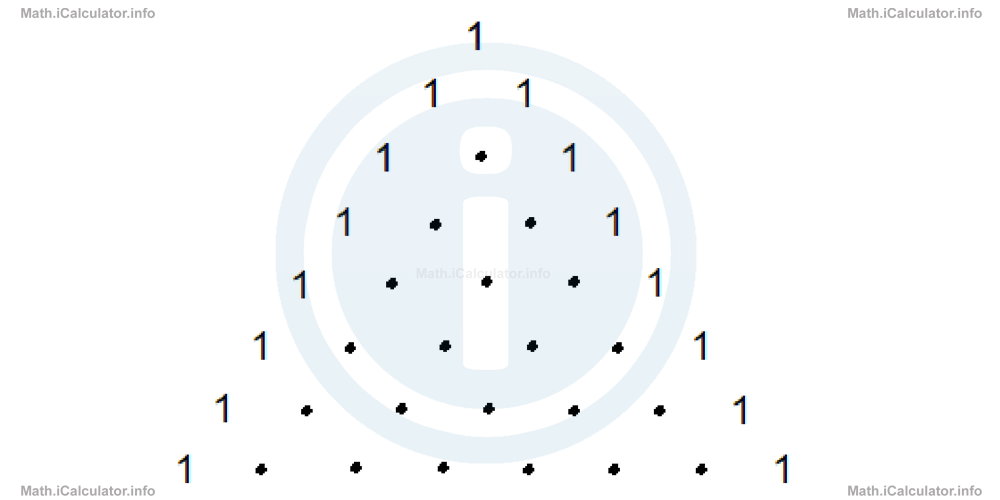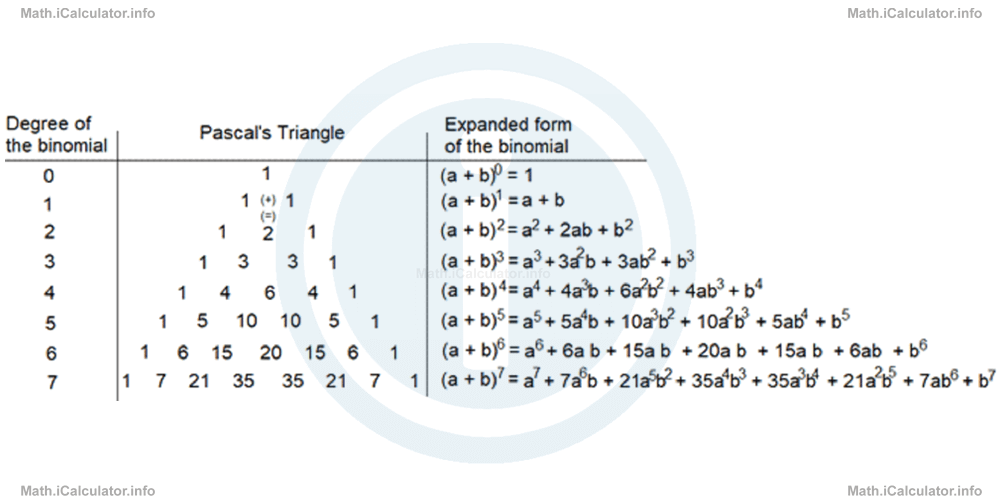Menu
Math Lesson 12.3.3 - Using Pascal's Triangle
Please provide a rating, it takes seconds and helps us to keep this resource free for all to use
Welcome to our Math lesson on Using Pascal's Triangle, this is the third lesson of our suite of math lessons covering the topic of Binomial Expansion and Coefficients, you can find links to the other lessons within this tutorial and access additional Math learning resources below this lesson.
Pascal's Triangle Explained
Pascal's Tringle is a kind of equilateral triangle, where the lateral sides represent the coefficients preceding the highest degree terms an and bn. As we said above, these coefficients are always 1. This means the lateral sides of the Pascal's Tringle contain only ones.
The value in the upper vertex is also 1, as this point represents the intercept of the two lateral lines. In this way, we obtain the following general form of the Pascal's Triangle:

The black dots must be replaced with the other coefficients of the binomial according to the following rules:
- Each row represents the degree of the binomial starting from zero (in the uppermost row). The degree of the binomial increases by 1 each time we get to a lower row.
- The power of the first variable decreases by 1 when moving from left to right in the same row while the power of the second variable increases by 1 when moving from left to right in the same row.
- The sum of two adjacent numbers in a certain row give the coefficient of the term below them. For example, in the second row, we have two 1s. Therefore, the coefficient of the term below them is 1 + 1 = 2.
The Pascal's Triangle for binomials up to the 7th degree is shown in the table below. This table also shows the expanded form of these binomials in terms of the variables a and b.

Remark! The number of terms in the expanded form of a binomial is 1 more than the degree of the binomial. For example, (a + b)5 has 6 terms, (a + b)14 has 15 terms and so on.
Example 1
Expand the following binomials:
- (3x + 2y)4
- (2 - 4x)5
Solution 1
- We take a = 3x and b = 2y. Thus, since from the Pascal's triangle (a + b)4 = a4 + 4a3 b + 6a2 b2 + 4ab3 + b4we obtain after substituting the original terms in the above expression:(3x + 2y)4
= (3x)4 + 4 ∙ (3x)3 ∙ (2y) + 6 ∙ (3x)2 ∙ (2y)2 + 4 ∙ (3x) ∙ (2y)3 + (2y)4
= 81x4 + 4 ∙ 27x3 ∙ 2y + 6 ∙ 9x2 ∙ 4y2 + 4 ∙ 3x ∙ 8y3 + 16y4
= 81x4 + 216x3 y + 216x2 y2 + 96xy3 + 16y4 - Again, we can take a = 2 and b = -4x. Thus, since from the Pascal's triangle (a + b)5 = a5 + 5a4 b + 10a3 b2 + 10a2 b3 + 5ab4 + b5we obtain after substituting the original terms in the above expression:(2-4x)5Since a polynomial is written from the term with the highest degree to that with the lowest one, we can write the above expression as
= 25 + 5 ∙ 24 ∙ (-4x) + 10 ∙ 23 ∙ (-4x)2 + 10 ∙ 22 ∙ (-4x)3 + 5 ∙ 2 ∙ (-2x)4 + (-2x)5
= 32 + 5 ∙ 14 ∙ (-4x) + 10 ∙ 8 ∙ 16x2 + 10 ∙ 4 ∙ (-64x3 ) + 5 ∙ 2 ∙ 16x4 + (-32x5 )
= 32 - 280x + 1280x2-2560x3 + 160x4 - 32x5(2 - 4x)5 = -32x5 + 160x4 - 2560x3 + 1280x2 - 280x + 32
As you see, the above expansions take only a few minutes when made using Pascal's Triangle. If the long method discussed at the beginning of this tutorial was used, it would take much more time to expand the above binomials.
More Binomial Expansion and Coefficients Lessons and Learning Resources
Whats next?
Enjoy the "Using Pascal's Triangle" math lesson? People who liked the "Binomial Expansion and Coefficients lesson found the following resources useful:
- Pascals Triangle Feedback. Helps other - Leave a rating for this pascals triangle (see below)
- Sequences and Series Math tutorial: Binomial Expansion and Coefficients. Read the Binomial Expansion and Coefficients math tutorial and build your math knowledge of Sequences and Series
- Sequences and Series Video tutorial: Binomial Expansion and Coefficients. Watch or listen to the Binomial Expansion and Coefficients video tutorial, a useful way to help you revise when travelling to and from school/college
- Sequences and Series Revision Notes: Binomial Expansion and Coefficients. Print the notes so you can revise the key points covered in the math tutorial for Binomial Expansion and Coefficients
- Sequences and Series Practice Questions: Binomial Expansion and Coefficients. Test and improve your knowledge of Binomial Expansion and Coefficients with example questins and answers
- Check your calculations for Sequences and Series questions with our excellent Sequences and Series calculators which contain full equations and calculations clearly displayed line by line. See the Sequences and Series Calculators by iCalculator™ below.
- Continuing learning sequences and series - read our next math tutorial: Infinite Series Explained
Help others Learning Math just like you
Please provide a rating, it takes seconds and helps us to keep this resource free for all to use
We hope you found this Math tutorial "Binomial Expansion and Coefficients" useful. If you did it would be great if you could spare the time to rate this math tutorial (simply click on the number of stars that match your assessment of this math learning aide) and/or share on social media, this helps us identify popular tutorials and calculators and expand our free learning resources to support our users around the world have free access to expand their knowledge of math and other disciplines.